Ethical Issues relating to Ethical Robots: Review and Reflection
VerifiedAdded on 2023/04/11
|8
|3079
|94
AI Summary
This report discusses the ethical issues related to ethical robots and provides a personal reflection on the impact of robots in society and workplaces. It reviews the article 'The Dark Side of Ethical Robots' by Vanderelst and Winfield and highlights the concerns over risks associated with AI advancements. The report also explores the different types of ethical robots and discusses the potential ethical issues in businesses, such as misinformation and high intelligence. The reflection section explores the benefits and drawbacks of using robots in the workplace.
Contribute Materials
Your contribution can guide someone’s learning journey. Share your
documents today.
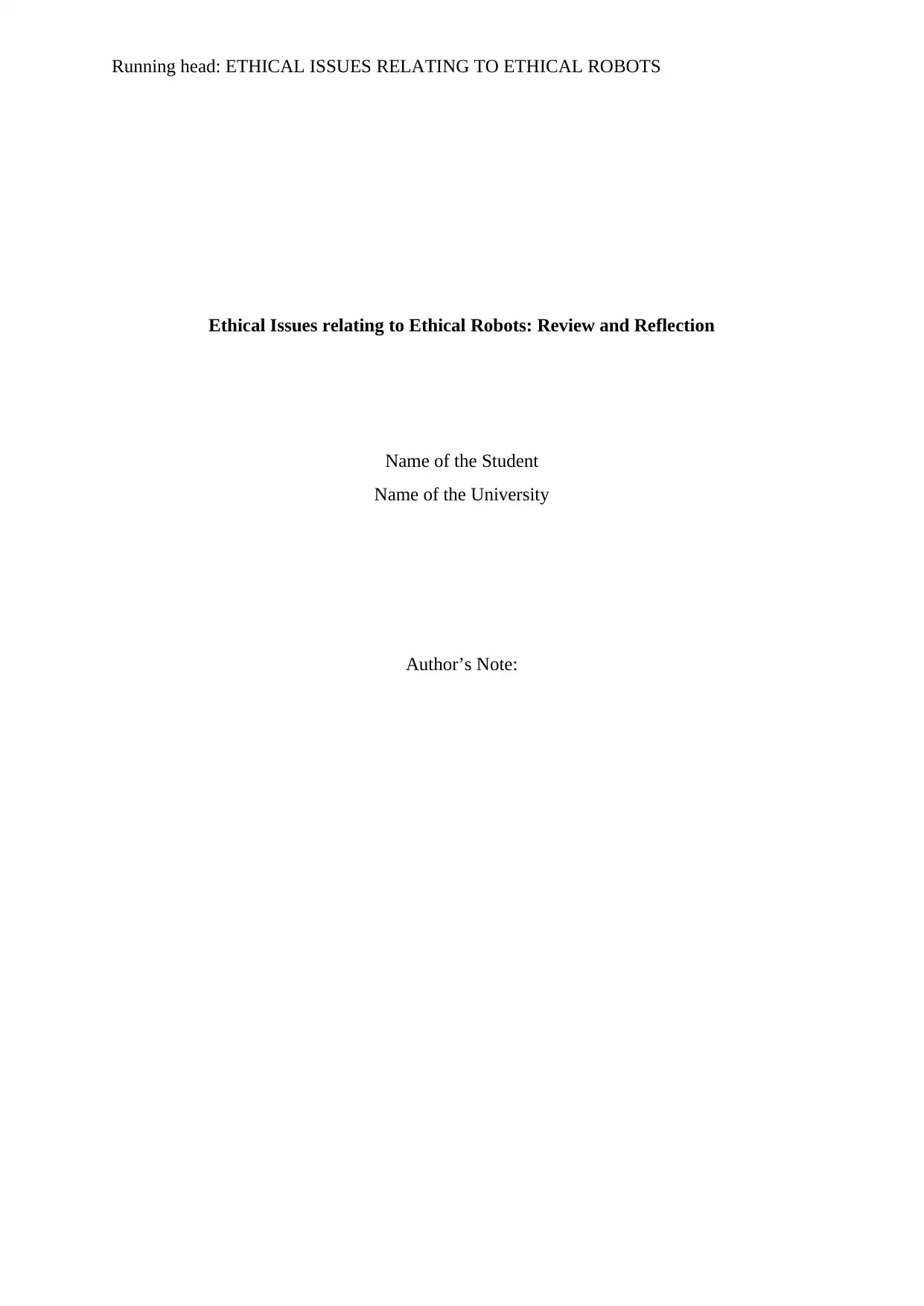
Running head: ETHICAL ISSUES RELATING TO ETHICAL ROBOTS
Ethical Issues relating to Ethical Robots: Review and Reflection
Name of the Student
Name of the University
Author’s Note:
Ethical Issues relating to Ethical Robots: Review and Reflection
Name of the Student
Name of the University
Author’s Note:
Secure Best Marks with AI Grader
Need help grading? Try our AI Grader for instant feedback on your assignments.

1
ETHICAL ISSUES RELATING TO ETHICAL ROBOTS
Table of Contents
1. Introduction............................................................................................................................2
2. Discussion..............................................................................................................................2
3. Reflection...............................................................................................................................5
4. Conclusion..............................................................................................................................5
References..................................................................................................................................6
ETHICAL ISSUES RELATING TO ETHICAL ROBOTS
Table of Contents
1. Introduction............................................................................................................................2
2. Discussion..............................................................................................................................2
3. Reflection...............................................................................................................................5
4. Conclusion..............................................................................................................................5
References..................................................................................................................................6
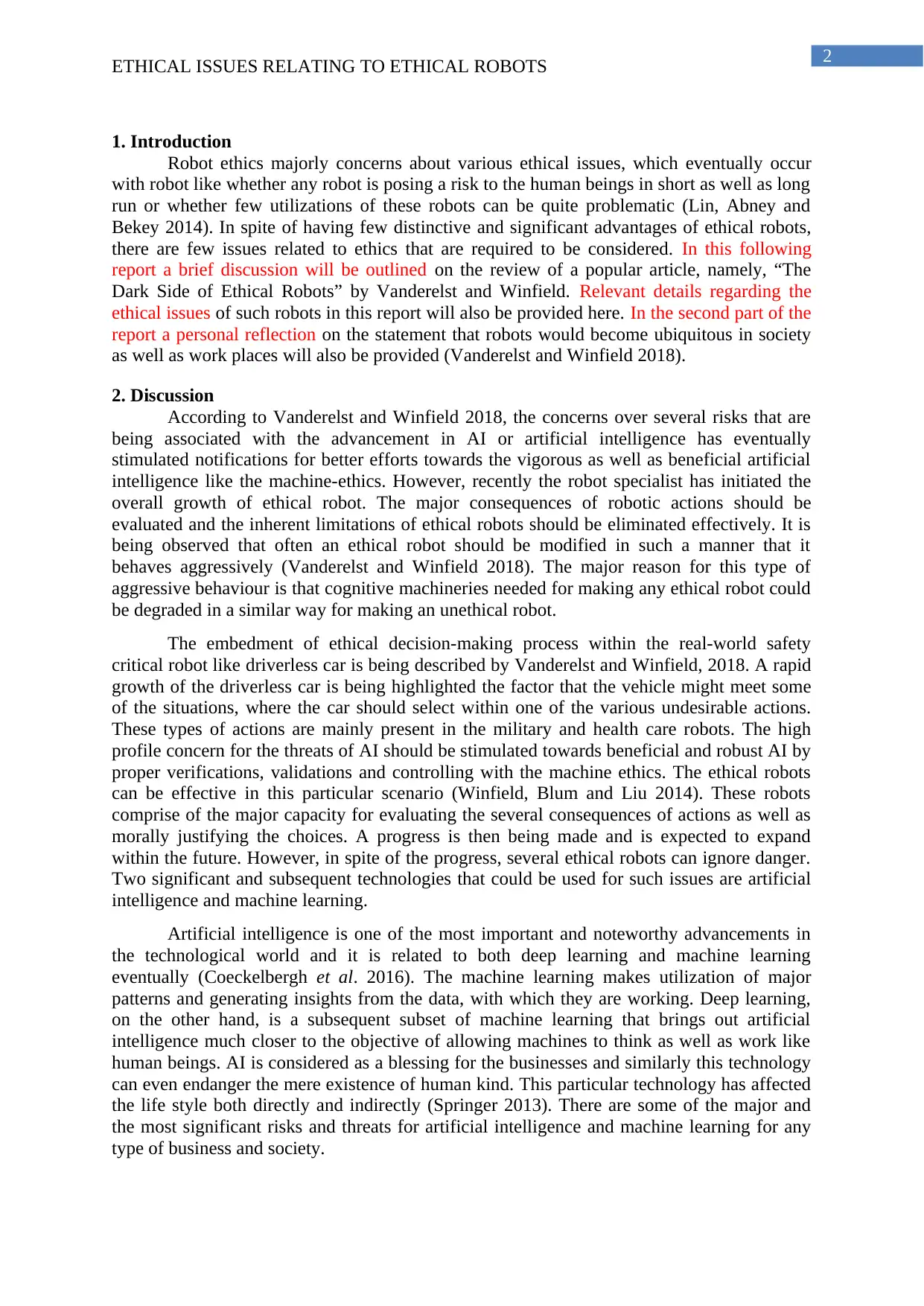
2
ETHICAL ISSUES RELATING TO ETHICAL ROBOTS
1. Introduction
Robot ethics majorly concerns about various ethical issues, which eventually occur
with robot like whether any robot is posing a risk to the human beings in short as well as long
run or whether few utilizations of these robots can be quite problematic (Lin, Abney and
Bekey 2014). In spite of having few distinctive and significant advantages of ethical robots,
there are few issues related to ethics that are required to be considered. In this following
report a brief discussion will be outlined on the review of a popular article, namely, “The
Dark Side of Ethical Robots” by Vanderelst and Winfield. Relevant details regarding the
ethical issues of such robots in this report will also be provided here. In the second part of the
report a personal reflection on the statement that robots would become ubiquitous in society
as well as work places will also be provided (Vanderelst and Winfield 2018).
2. Discussion
According to Vanderelst and Winfield 2018, the concerns over several risks that are
being associated with the advancement in AI or artificial intelligence has eventually
stimulated notifications for better efforts towards the vigorous as well as beneficial artificial
intelligence like the machine-ethics. However, recently the robot specialist has initiated the
overall growth of ethical robot. The major consequences of robotic actions should be
evaluated and the inherent limitations of ethical robots should be eliminated effectively. It is
being observed that often an ethical robot should be modified in such a manner that it
behaves aggressively (Vanderelst and Winfield 2018). The major reason for this type of
aggressive behaviour is that cognitive machineries needed for making any ethical robot could
be degraded in a similar way for making an unethical robot.
The embedment of ethical decision-making process within the real-world safety
critical robot like driverless car is being described by Vanderelst and Winfield, 2018. A rapid
growth of the driverless car is being highlighted the factor that the vehicle might meet some
of the situations, where the car should select within one of the various undesirable actions.
These types of actions are mainly present in the military and health care robots. The high
profile concern for the threats of AI should be stimulated towards beneficial and robust AI by
proper verifications, validations and controlling with the machine ethics. The ethical robots
can be effective in this particular scenario (Winfield, Blum and Liu 2014). These robots
comprise of the major capacity for evaluating the several consequences of actions as well as
morally justifying the choices. A progress is then being made and is expected to expand
within the future. However, in spite of the progress, several ethical robots can ignore danger.
Two significant and subsequent technologies that could be used for such issues are artificial
intelligence and machine learning.
Artificial intelligence is one of the most important and noteworthy advancements in
the technological world and it is related to both deep learning and machine learning
eventually (Coeckelbergh et al. 2016). The machine learning makes utilization of major
patterns and generating insights from the data, with which they are working. Deep learning,
on the other hand, is a subsequent subset of machine learning that brings out artificial
intelligence much closer to the objective of allowing machines to think as well as work like
human beings. AI is considered as a blessing for the businesses and similarly this technology
can even endanger the mere existence of human kind. This particular technology has affected
the life style both directly and indirectly (Springer 2013). There are some of the major and
the most significant risks and threats for artificial intelligence and machine learning for any
type of business and society.
ETHICAL ISSUES RELATING TO ETHICAL ROBOTS
1. Introduction
Robot ethics majorly concerns about various ethical issues, which eventually occur
with robot like whether any robot is posing a risk to the human beings in short as well as long
run or whether few utilizations of these robots can be quite problematic (Lin, Abney and
Bekey 2014). In spite of having few distinctive and significant advantages of ethical robots,
there are few issues related to ethics that are required to be considered. In this following
report a brief discussion will be outlined on the review of a popular article, namely, “The
Dark Side of Ethical Robots” by Vanderelst and Winfield. Relevant details regarding the
ethical issues of such robots in this report will also be provided here. In the second part of the
report a personal reflection on the statement that robots would become ubiquitous in society
as well as work places will also be provided (Vanderelst and Winfield 2018).
2. Discussion
According to Vanderelst and Winfield 2018, the concerns over several risks that are
being associated with the advancement in AI or artificial intelligence has eventually
stimulated notifications for better efforts towards the vigorous as well as beneficial artificial
intelligence like the machine-ethics. However, recently the robot specialist has initiated the
overall growth of ethical robot. The major consequences of robotic actions should be
evaluated and the inherent limitations of ethical robots should be eliminated effectively. It is
being observed that often an ethical robot should be modified in such a manner that it
behaves aggressively (Vanderelst and Winfield 2018). The major reason for this type of
aggressive behaviour is that cognitive machineries needed for making any ethical robot could
be degraded in a similar way for making an unethical robot.
The embedment of ethical decision-making process within the real-world safety
critical robot like driverless car is being described by Vanderelst and Winfield, 2018. A rapid
growth of the driverless car is being highlighted the factor that the vehicle might meet some
of the situations, where the car should select within one of the various undesirable actions.
These types of actions are mainly present in the military and health care robots. The high
profile concern for the threats of AI should be stimulated towards beneficial and robust AI by
proper verifications, validations and controlling with the machine ethics. The ethical robots
can be effective in this particular scenario (Winfield, Blum and Liu 2014). These robots
comprise of the major capacity for evaluating the several consequences of actions as well as
morally justifying the choices. A progress is then being made and is expected to expand
within the future. However, in spite of the progress, several ethical robots can ignore danger.
Two significant and subsequent technologies that could be used for such issues are artificial
intelligence and machine learning.
Artificial intelligence is one of the most important and noteworthy advancements in
the technological world and it is related to both deep learning and machine learning
eventually (Coeckelbergh et al. 2016). The machine learning makes utilization of major
patterns and generating insights from the data, with which they are working. Deep learning,
on the other hand, is a subsequent subset of machine learning that brings out artificial
intelligence much closer to the objective of allowing machines to think as well as work like
human beings. AI is considered as a blessing for the businesses and similarly this technology
can even endanger the mere existence of human kind. This particular technology has affected
the life style both directly and indirectly (Springer 2013). There are some of the major and
the most significant risks and threats for artificial intelligence and machine learning for any
type of business and society.
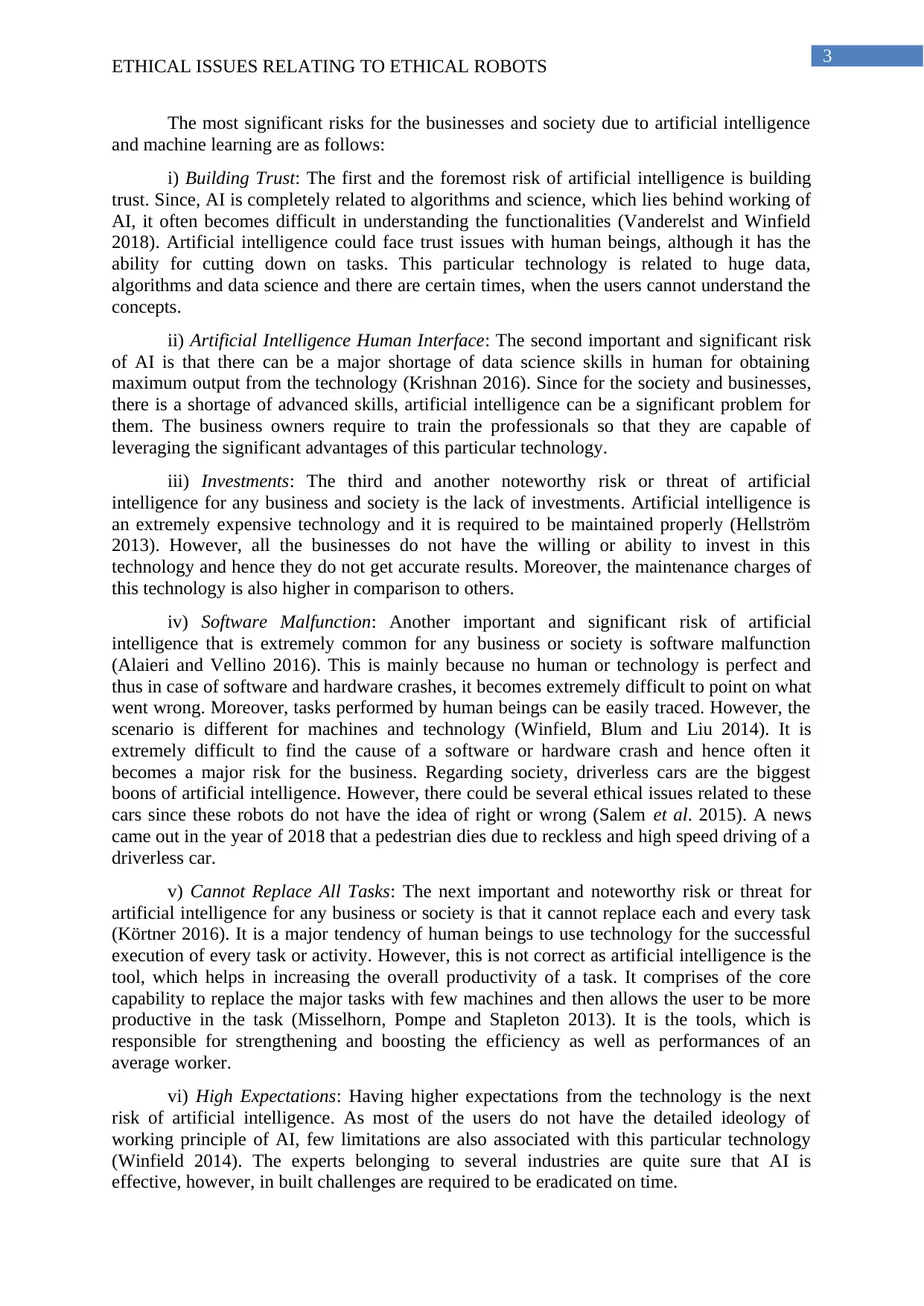
3
ETHICAL ISSUES RELATING TO ETHICAL ROBOTS
The most significant risks for the businesses and society due to artificial intelligence
and machine learning are as follows:
i) Building Trust: The first and the foremost risk of artificial intelligence is building
trust. Since, AI is completely related to algorithms and science, which lies behind working of
AI, it often becomes difficult in understanding the functionalities (Vanderelst and Winfield
2018). Artificial intelligence could face trust issues with human beings, although it has the
ability for cutting down on tasks. This particular technology is related to huge data,
algorithms and data science and there are certain times, when the users cannot understand the
concepts.
ii) Artificial Intelligence Human Interface: The second important and significant risk
of AI is that there can be a major shortage of data science skills in human for obtaining
maximum output from the technology (Krishnan 2016). Since for the society and businesses,
there is a shortage of advanced skills, artificial intelligence can be a significant problem for
them. The business owners require to train the professionals so that they are capable of
leveraging the significant advantages of this particular technology.
iii) Investments: The third and another noteworthy risk or threat of artificial
intelligence for any business and society is the lack of investments. Artificial intelligence is
an extremely expensive technology and it is required to be maintained properly (Hellström
2013). However, all the businesses do not have the willing or ability to invest in this
technology and hence they do not get accurate results. Moreover, the maintenance charges of
this technology is also higher in comparison to others.
iv) Software Malfunction: Another important and significant risk of artificial
intelligence that is extremely common for any business or society is software malfunction
(Alaieri and Vellino 2016). This is mainly because no human or technology is perfect and
thus in case of software and hardware crashes, it becomes extremely difficult to point on what
went wrong. Moreover, tasks performed by human beings can be easily traced. However, the
scenario is different for machines and technology (Winfield, Blum and Liu 2014). It is
extremely difficult to find the cause of a software or hardware crash and hence often it
becomes a major risk for the business. Regarding society, driverless cars are the biggest
boons of artificial intelligence. However, there could be several ethical issues related to these
cars since these robots do not have the idea of right or wrong (Salem et al. 2015). A news
came out in the year of 2018 that a pedestrian dies due to reckless and high speed driving of a
driverless car.
v) Cannot Replace All Tasks: The next important and noteworthy risk or threat for
artificial intelligence for any business or society is that it cannot replace each and every task
(Körtner 2016). It is a major tendency of human beings to use technology for the successful
execution of every task or activity. However, this is not correct as artificial intelligence is the
tool, which helps in increasing the overall productivity of a task. It comprises of the core
capability to replace the major tasks with few machines and then allows the user to be more
productive in the task (Misselhorn, Pompe and Stapleton 2013). It is the tools, which is
responsible for strengthening and boosting the efficiency as well as performances of an
average worker.
vi) High Expectations: Having higher expectations from the technology is the next
risk of artificial intelligence. As most of the users do not have the detailed ideology of
working principle of AI, few limitations are also associated with this particular technology
(Winfield 2014). The experts belonging to several industries are quite sure that AI is
effective, however, in built challenges are required to be eradicated on time.
ETHICAL ISSUES RELATING TO ETHICAL ROBOTS
The most significant risks for the businesses and society due to artificial intelligence
and machine learning are as follows:
i) Building Trust: The first and the foremost risk of artificial intelligence is building
trust. Since, AI is completely related to algorithms and science, which lies behind working of
AI, it often becomes difficult in understanding the functionalities (Vanderelst and Winfield
2018). Artificial intelligence could face trust issues with human beings, although it has the
ability for cutting down on tasks. This particular technology is related to huge data,
algorithms and data science and there are certain times, when the users cannot understand the
concepts.
ii) Artificial Intelligence Human Interface: The second important and significant risk
of AI is that there can be a major shortage of data science skills in human for obtaining
maximum output from the technology (Krishnan 2016). Since for the society and businesses,
there is a shortage of advanced skills, artificial intelligence can be a significant problem for
them. The business owners require to train the professionals so that they are capable of
leveraging the significant advantages of this particular technology.
iii) Investments: The third and another noteworthy risk or threat of artificial
intelligence for any business and society is the lack of investments. Artificial intelligence is
an extremely expensive technology and it is required to be maintained properly (Hellström
2013). However, all the businesses do not have the willing or ability to invest in this
technology and hence they do not get accurate results. Moreover, the maintenance charges of
this technology is also higher in comparison to others.
iv) Software Malfunction: Another important and significant risk of artificial
intelligence that is extremely common for any business or society is software malfunction
(Alaieri and Vellino 2016). This is mainly because no human or technology is perfect and
thus in case of software and hardware crashes, it becomes extremely difficult to point on what
went wrong. Moreover, tasks performed by human beings can be easily traced. However, the
scenario is different for machines and technology (Winfield, Blum and Liu 2014). It is
extremely difficult to find the cause of a software or hardware crash and hence often it
becomes a major risk for the business. Regarding society, driverless cars are the biggest
boons of artificial intelligence. However, there could be several ethical issues related to these
cars since these robots do not have the idea of right or wrong (Salem et al. 2015). A news
came out in the year of 2018 that a pedestrian dies due to reckless and high speed driving of a
driverless car.
v) Cannot Replace All Tasks: The next important and noteworthy risk or threat for
artificial intelligence for any business or society is that it cannot replace each and every task
(Körtner 2016). It is a major tendency of human beings to use technology for the successful
execution of every task or activity. However, this is not correct as artificial intelligence is the
tool, which helps in increasing the overall productivity of a task. It comprises of the core
capability to replace the major tasks with few machines and then allows the user to be more
productive in the task (Misselhorn, Pompe and Stapleton 2013). It is the tools, which is
responsible for strengthening and boosting the efficiency as well as performances of an
average worker.
vi) High Expectations: Having higher expectations from the technology is the next
risk of artificial intelligence. As most of the users do not have the detailed ideology of
working principle of AI, few limitations are also associated with this particular technology
(Winfield 2014). The experts belonging to several industries are quite sure that AI is
effective, however, in built challenges are required to be eradicated on time.
Secure Best Marks with AI Grader
Need help grading? Try our AI Grader for instant feedback on your assignments.
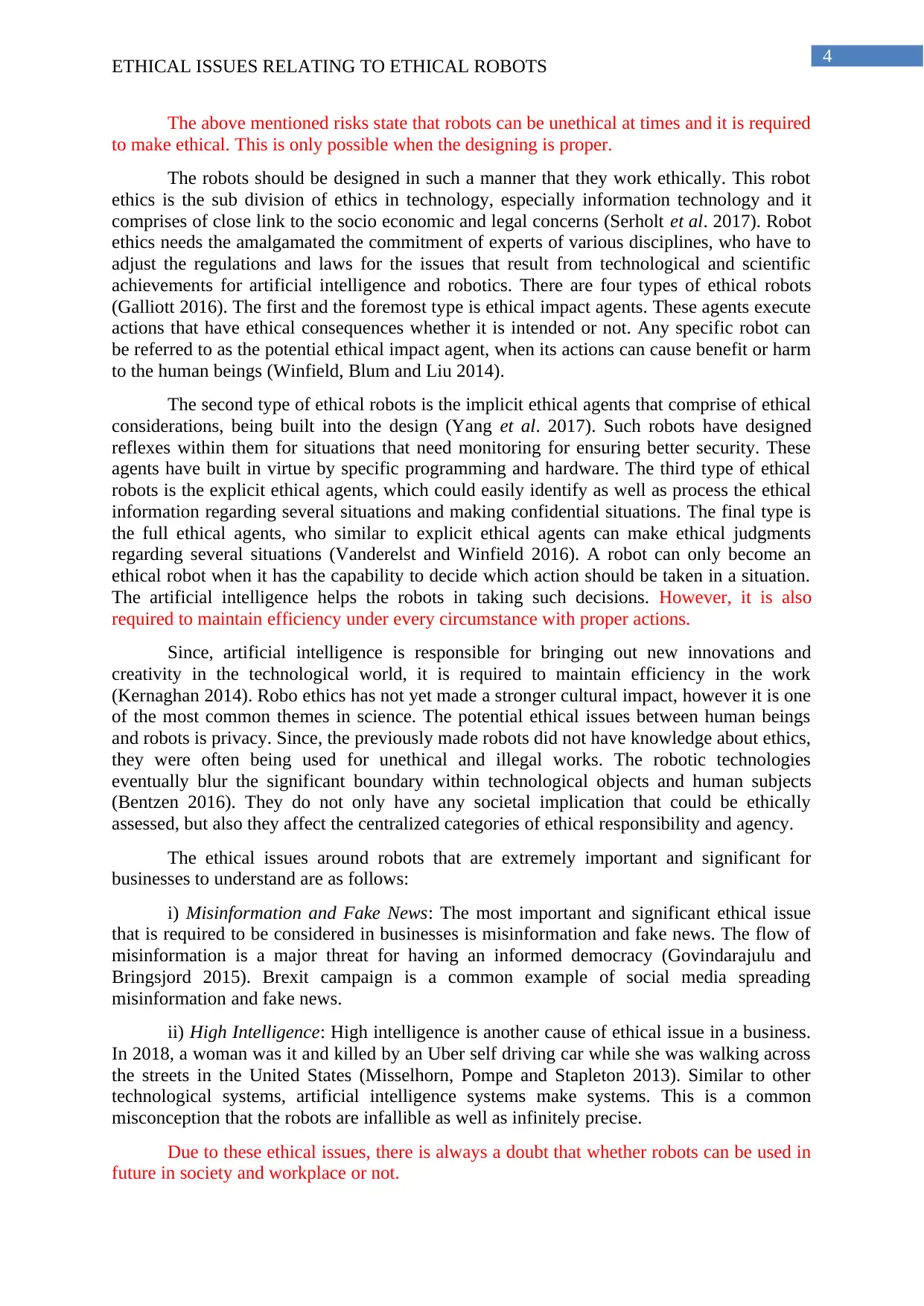
4
ETHICAL ISSUES RELATING TO ETHICAL ROBOTS
The above mentioned risks state that robots can be unethical at times and it is required
to make ethical. This is only possible when the designing is proper.
The robots should be designed in such a manner that they work ethically. This robot
ethics is the sub division of ethics in technology, especially information technology and it
comprises of close link to the socio economic and legal concerns (Serholt et al. 2017). Robot
ethics needs the amalgamated the commitment of experts of various disciplines, who have to
adjust the regulations and laws for the issues that result from technological and scientific
achievements for artificial intelligence and robotics. There are four types of ethical robots
(Galliott 2016). The first and the foremost type is ethical impact agents. These agents execute
actions that have ethical consequences whether it is intended or not. Any specific robot can
be referred to as the potential ethical impact agent, when its actions can cause benefit or harm
to the human beings (Winfield, Blum and Liu 2014).
The second type of ethical robots is the implicit ethical agents that comprise of ethical
considerations, being built into the design (Yang et al. 2017). Such robots have designed
reflexes within them for situations that need monitoring for ensuring better security. These
agents have built in virtue by specific programming and hardware. The third type of ethical
robots is the explicit ethical agents, which could easily identify as well as process the ethical
information regarding several situations and making confidential situations. The final type is
the full ethical agents, who similar to explicit ethical agents can make ethical judgments
regarding several situations (Vanderelst and Winfield 2016). A robot can only become an
ethical robot when it has the capability to decide which action should be taken in a situation.
The artificial intelligence helps the robots in taking such decisions. However, it is also
required to maintain efficiency under every circumstance with proper actions.
Since, artificial intelligence is responsible for bringing out new innovations and
creativity in the technological world, it is required to maintain efficiency in the work
(Kernaghan 2014). Robo ethics has not yet made a stronger cultural impact, however it is one
of the most common themes in science. The potential ethical issues between human beings
and robots is privacy. Since, the previously made robots did not have knowledge about ethics,
they were often being used for unethical and illegal works. The robotic technologies
eventually blur the significant boundary within technological objects and human subjects
(Bentzen 2016). They do not only have any societal implication that could be ethically
assessed, but also they affect the centralized categories of ethical responsibility and agency.
The ethical issues around robots that are extremely important and significant for
businesses to understand are as follows:
i) Misinformation and Fake News: The most important and significant ethical issue
that is required to be considered in businesses is misinformation and fake news. The flow of
misinformation is a major threat for having an informed democracy (Govindarajulu and
Bringsjord 2015). Brexit campaign is a common example of social media spreading
misinformation and fake news.
ii) High Intelligence: High intelligence is another cause of ethical issue in a business.
In 2018, a woman was it and killed by an Uber self driving car while she was walking across
the streets in the United States (Misselhorn, Pompe and Stapleton 2013). Similar to other
technological systems, artificial intelligence systems make systems. This is a common
misconception that the robots are infallible as well as infinitely precise.
Due to these ethical issues, there is always a doubt that whether robots can be used in
future in society and workplace or not.
ETHICAL ISSUES RELATING TO ETHICAL ROBOTS
The above mentioned risks state that robots can be unethical at times and it is required
to make ethical. This is only possible when the designing is proper.
The robots should be designed in such a manner that they work ethically. This robot
ethics is the sub division of ethics in technology, especially information technology and it
comprises of close link to the socio economic and legal concerns (Serholt et al. 2017). Robot
ethics needs the amalgamated the commitment of experts of various disciplines, who have to
adjust the regulations and laws for the issues that result from technological and scientific
achievements for artificial intelligence and robotics. There are four types of ethical robots
(Galliott 2016). The first and the foremost type is ethical impact agents. These agents execute
actions that have ethical consequences whether it is intended or not. Any specific robot can
be referred to as the potential ethical impact agent, when its actions can cause benefit or harm
to the human beings (Winfield, Blum and Liu 2014).
The second type of ethical robots is the implicit ethical agents that comprise of ethical
considerations, being built into the design (Yang et al. 2017). Such robots have designed
reflexes within them for situations that need monitoring for ensuring better security. These
agents have built in virtue by specific programming and hardware. The third type of ethical
robots is the explicit ethical agents, which could easily identify as well as process the ethical
information regarding several situations and making confidential situations. The final type is
the full ethical agents, who similar to explicit ethical agents can make ethical judgments
regarding several situations (Vanderelst and Winfield 2016). A robot can only become an
ethical robot when it has the capability to decide which action should be taken in a situation.
The artificial intelligence helps the robots in taking such decisions. However, it is also
required to maintain efficiency under every circumstance with proper actions.
Since, artificial intelligence is responsible for bringing out new innovations and
creativity in the technological world, it is required to maintain efficiency in the work
(Kernaghan 2014). Robo ethics has not yet made a stronger cultural impact, however it is one
of the most common themes in science. The potential ethical issues between human beings
and robots is privacy. Since, the previously made robots did not have knowledge about ethics,
they were often being used for unethical and illegal works. The robotic technologies
eventually blur the significant boundary within technological objects and human subjects
(Bentzen 2016). They do not only have any societal implication that could be ethically
assessed, but also they affect the centralized categories of ethical responsibility and agency.
The ethical issues around robots that are extremely important and significant for
businesses to understand are as follows:
i) Misinformation and Fake News: The most important and significant ethical issue
that is required to be considered in businesses is misinformation and fake news. The flow of
misinformation is a major threat for having an informed democracy (Govindarajulu and
Bringsjord 2015). Brexit campaign is a common example of social media spreading
misinformation and fake news.
ii) High Intelligence: High intelligence is another cause of ethical issue in a business.
In 2018, a woman was it and killed by an Uber self driving car while she was walking across
the streets in the United States (Misselhorn, Pompe and Stapleton 2013). Similar to other
technological systems, artificial intelligence systems make systems. This is a common
misconception that the robots are infallible as well as infinitely precise.
Due to these ethical issues, there is always a doubt that whether robots can be used in
future in society and workplace or not.
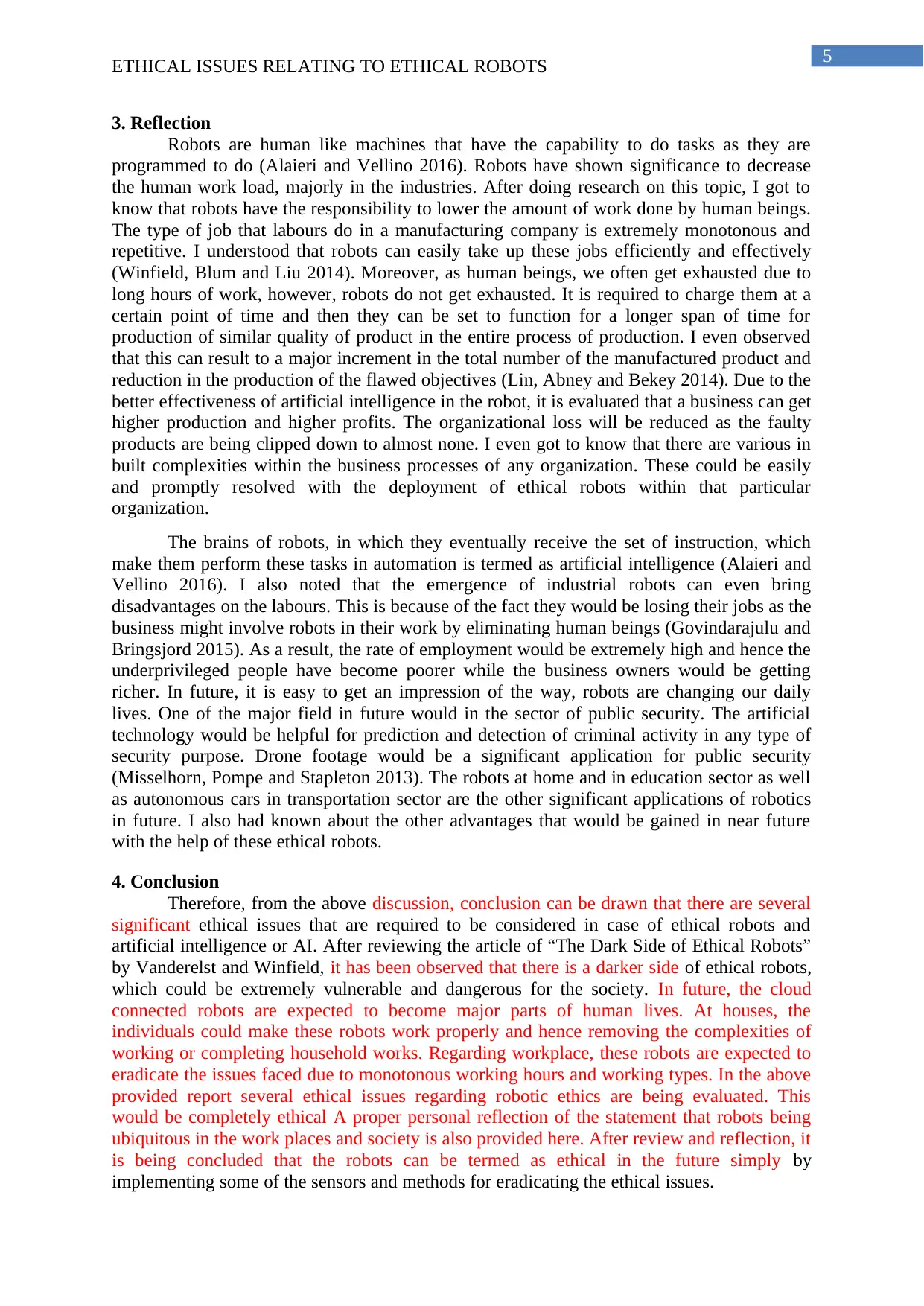
5
ETHICAL ISSUES RELATING TO ETHICAL ROBOTS
3. Reflection
Robots are human like machines that have the capability to do tasks as they are
programmed to do (Alaieri and Vellino 2016). Robots have shown significance to decrease
the human work load, majorly in the industries. After doing research on this topic, I got to
know that robots have the responsibility to lower the amount of work done by human beings.
The type of job that labours do in a manufacturing company is extremely monotonous and
repetitive. I understood that robots can easily take up these jobs efficiently and effectively
(Winfield, Blum and Liu 2014). Moreover, as human beings, we often get exhausted due to
long hours of work, however, robots do not get exhausted. It is required to charge them at a
certain point of time and then they can be set to function for a longer span of time for
production of similar quality of product in the entire process of production. I even observed
that this can result to a major increment in the total number of the manufactured product and
reduction in the production of the flawed objectives (Lin, Abney and Bekey 2014). Due to the
better effectiveness of artificial intelligence in the robot, it is evaluated that a business can get
higher production and higher profits. The organizational loss will be reduced as the faulty
products are being clipped down to almost none. I even got to know that there are various in
built complexities within the business processes of any organization. These could be easily
and promptly resolved with the deployment of ethical robots within that particular
organization.
The brains of robots, in which they eventually receive the set of instruction, which
make them perform these tasks in automation is termed as artificial intelligence (Alaieri and
Vellino 2016). I also noted that the emergence of industrial robots can even bring
disadvantages on the labours. This is because of the fact they would be losing their jobs as the
business might involve robots in their work by eliminating human beings (Govindarajulu and
Bringsjord 2015). As a result, the rate of employment would be extremely high and hence the
underprivileged people have become poorer while the business owners would be getting
richer. In future, it is easy to get an impression of the way, robots are changing our daily
lives. One of the major field in future would in the sector of public security. The artificial
technology would be helpful for prediction and detection of criminal activity in any type of
security purpose. Drone footage would be a significant application for public security
(Misselhorn, Pompe and Stapleton 2013). The robots at home and in education sector as well
as autonomous cars in transportation sector are the other significant applications of robotics
in future. I also had known about the other advantages that would be gained in near future
with the help of these ethical robots.
4. Conclusion
Therefore, from the above discussion, conclusion can be drawn that there are several
significant ethical issues that are required to be considered in case of ethical robots and
artificial intelligence or AI. After reviewing the article of “The Dark Side of Ethical Robots”
by Vanderelst and Winfield, it has been observed that there is a darker side of ethical robots,
which could be extremely vulnerable and dangerous for the society. In future, the cloud
connected robots are expected to become major parts of human lives. At houses, the
individuals could make these robots work properly and hence removing the complexities of
working or completing household works. Regarding workplace, these robots are expected to
eradicate the issues faced due to monotonous working hours and working types. In the above
provided report several ethical issues regarding robotic ethics are being evaluated. This
would be completely ethical A proper personal reflection of the statement that robots being
ubiquitous in the work places and society is also provided here. After review and reflection, it
is being concluded that the robots can be termed as ethical in the future simply by
implementing some of the sensors and methods for eradicating the ethical issues.
ETHICAL ISSUES RELATING TO ETHICAL ROBOTS
3. Reflection
Robots are human like machines that have the capability to do tasks as they are
programmed to do (Alaieri and Vellino 2016). Robots have shown significance to decrease
the human work load, majorly in the industries. After doing research on this topic, I got to
know that robots have the responsibility to lower the amount of work done by human beings.
The type of job that labours do in a manufacturing company is extremely monotonous and
repetitive. I understood that robots can easily take up these jobs efficiently and effectively
(Winfield, Blum and Liu 2014). Moreover, as human beings, we often get exhausted due to
long hours of work, however, robots do not get exhausted. It is required to charge them at a
certain point of time and then they can be set to function for a longer span of time for
production of similar quality of product in the entire process of production. I even observed
that this can result to a major increment in the total number of the manufactured product and
reduction in the production of the flawed objectives (Lin, Abney and Bekey 2014). Due to the
better effectiveness of artificial intelligence in the robot, it is evaluated that a business can get
higher production and higher profits. The organizational loss will be reduced as the faulty
products are being clipped down to almost none. I even got to know that there are various in
built complexities within the business processes of any organization. These could be easily
and promptly resolved with the deployment of ethical robots within that particular
organization.
The brains of robots, in which they eventually receive the set of instruction, which
make them perform these tasks in automation is termed as artificial intelligence (Alaieri and
Vellino 2016). I also noted that the emergence of industrial robots can even bring
disadvantages on the labours. This is because of the fact they would be losing their jobs as the
business might involve robots in their work by eliminating human beings (Govindarajulu and
Bringsjord 2015). As a result, the rate of employment would be extremely high and hence the
underprivileged people have become poorer while the business owners would be getting
richer. In future, it is easy to get an impression of the way, robots are changing our daily
lives. One of the major field in future would in the sector of public security. The artificial
technology would be helpful for prediction and detection of criminal activity in any type of
security purpose. Drone footage would be a significant application for public security
(Misselhorn, Pompe and Stapleton 2013). The robots at home and in education sector as well
as autonomous cars in transportation sector are the other significant applications of robotics
in future. I also had known about the other advantages that would be gained in near future
with the help of these ethical robots.
4. Conclusion
Therefore, from the above discussion, conclusion can be drawn that there are several
significant ethical issues that are required to be considered in case of ethical robots and
artificial intelligence or AI. After reviewing the article of “The Dark Side of Ethical Robots”
by Vanderelst and Winfield, it has been observed that there is a darker side of ethical robots,
which could be extremely vulnerable and dangerous for the society. In future, the cloud
connected robots are expected to become major parts of human lives. At houses, the
individuals could make these robots work properly and hence removing the complexities of
working or completing household works. Regarding workplace, these robots are expected to
eradicate the issues faced due to monotonous working hours and working types. In the above
provided report several ethical issues regarding robotic ethics are being evaluated. This
would be completely ethical A proper personal reflection of the statement that robots being
ubiquitous in the work places and society is also provided here. After review and reflection, it
is being concluded that the robots can be termed as ethical in the future simply by
implementing some of the sensors and methods for eradicating the ethical issues.
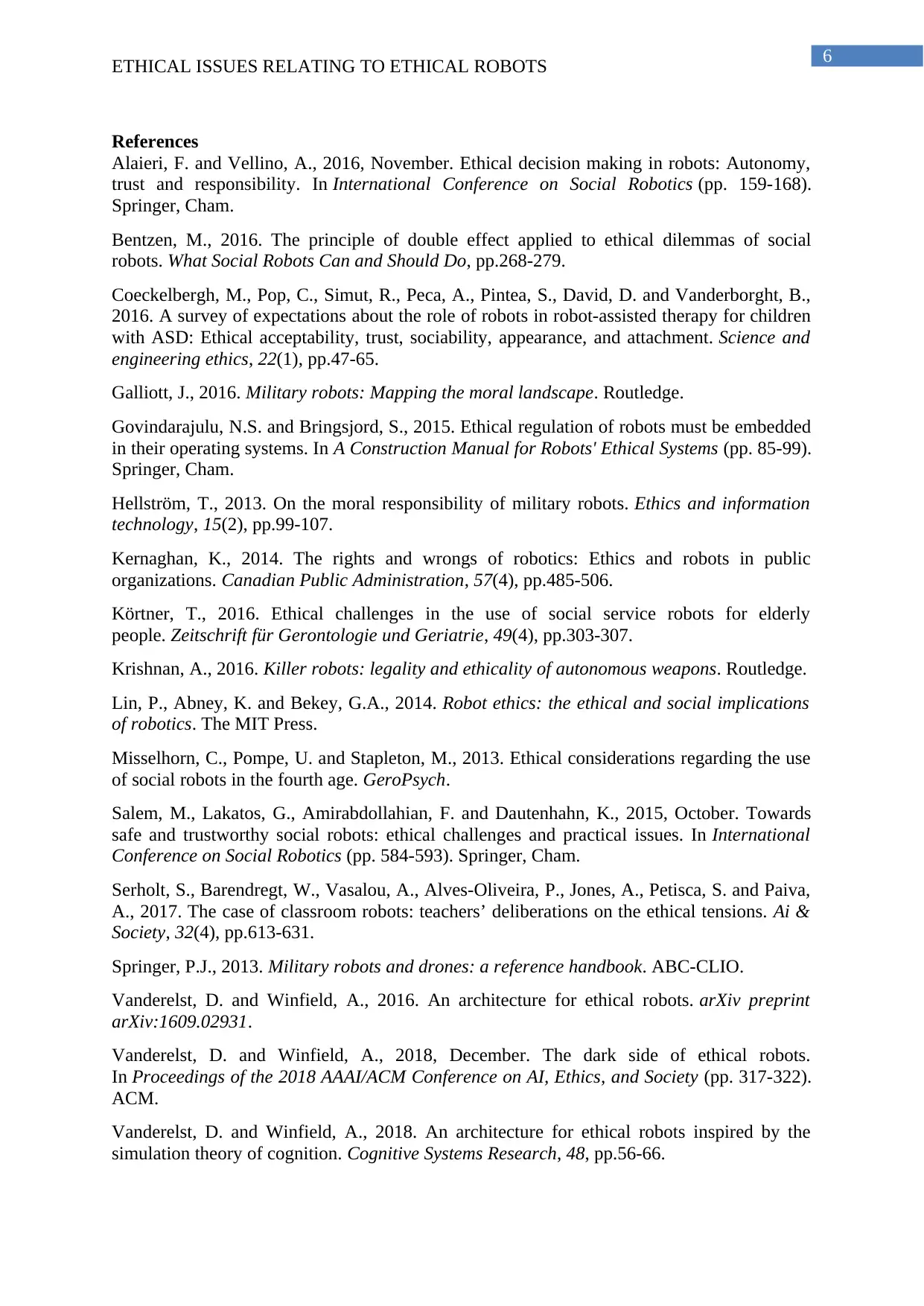
6
ETHICAL ISSUES RELATING TO ETHICAL ROBOTS
References
Alaieri, F. and Vellino, A., 2016, November. Ethical decision making in robots: Autonomy,
trust and responsibility. In International Conference on Social Robotics (pp. 159-168).
Springer, Cham.
Bentzen, M., 2016. The principle of double effect applied to ethical dilemmas of social
robots. What Social Robots Can and Should Do, pp.268-279.
Coeckelbergh, M., Pop, C., Simut, R., Peca, A., Pintea, S., David, D. and Vanderborght, B.,
2016. A survey of expectations about the role of robots in robot-assisted therapy for children
with ASD: Ethical acceptability, trust, sociability, appearance, and attachment. Science and
engineering ethics, 22(1), pp.47-65.
Galliott, J., 2016. Military robots: Mapping the moral landscape. Routledge.
Govindarajulu, N.S. and Bringsjord, S., 2015. Ethical regulation of robots must be embedded
in their operating systems. In A Construction Manual for Robots' Ethical Systems (pp. 85-99).
Springer, Cham.
Hellström, T., 2013. On the moral responsibility of military robots. Ethics and information
technology, 15(2), pp.99-107.
Kernaghan, K., 2014. The rights and wrongs of robotics: Ethics and robots in public
organizations. Canadian Public Administration, 57(4), pp.485-506.
Körtner, T., 2016. Ethical challenges in the use of social service robots for elderly
people. Zeitschrift für Gerontologie und Geriatrie, 49(4), pp.303-307.
Krishnan, A., 2016. Killer robots: legality and ethicality of autonomous weapons. Routledge.
Lin, P., Abney, K. and Bekey, G.A., 2014. Robot ethics: the ethical and social implications
of robotics. The MIT Press.
Misselhorn, C., Pompe, U. and Stapleton, M., 2013. Ethical considerations regarding the use
of social robots in the fourth age. GeroPsych.
Salem, M., Lakatos, G., Amirabdollahian, F. and Dautenhahn, K., 2015, October. Towards
safe and trustworthy social robots: ethical challenges and practical issues. In International
Conference on Social Robotics (pp. 584-593). Springer, Cham.
Serholt, S., Barendregt, W., Vasalou, A., Alves-Oliveira, P., Jones, A., Petisca, S. and Paiva,
A., 2017. The case of classroom robots: teachers’ deliberations on the ethical tensions. Ai &
Society, 32(4), pp.613-631.
Springer, P.J., 2013. Military robots and drones: a reference handbook. ABC-CLIO.
Vanderelst, D. and Winfield, A., 2016. An architecture for ethical robots. arXiv preprint
arXiv:1609.02931.
Vanderelst, D. and Winfield, A., 2018, December. The dark side of ethical robots.
In Proceedings of the 2018 AAAI/ACM Conference on AI, Ethics, and Society (pp. 317-322).
ACM.
Vanderelst, D. and Winfield, A., 2018. An architecture for ethical robots inspired by the
simulation theory of cognition. Cognitive Systems Research, 48, pp.56-66.
ETHICAL ISSUES RELATING TO ETHICAL ROBOTS
References
Alaieri, F. and Vellino, A., 2016, November. Ethical decision making in robots: Autonomy,
trust and responsibility. In International Conference on Social Robotics (pp. 159-168).
Springer, Cham.
Bentzen, M., 2016. The principle of double effect applied to ethical dilemmas of social
robots. What Social Robots Can and Should Do, pp.268-279.
Coeckelbergh, M., Pop, C., Simut, R., Peca, A., Pintea, S., David, D. and Vanderborght, B.,
2016. A survey of expectations about the role of robots in robot-assisted therapy for children
with ASD: Ethical acceptability, trust, sociability, appearance, and attachment. Science and
engineering ethics, 22(1), pp.47-65.
Galliott, J., 2016. Military robots: Mapping the moral landscape. Routledge.
Govindarajulu, N.S. and Bringsjord, S., 2015. Ethical regulation of robots must be embedded
in their operating systems. In A Construction Manual for Robots' Ethical Systems (pp. 85-99).
Springer, Cham.
Hellström, T., 2013. On the moral responsibility of military robots. Ethics and information
technology, 15(2), pp.99-107.
Kernaghan, K., 2014. The rights and wrongs of robotics: Ethics and robots in public
organizations. Canadian Public Administration, 57(4), pp.485-506.
Körtner, T., 2016. Ethical challenges in the use of social service robots for elderly
people. Zeitschrift für Gerontologie und Geriatrie, 49(4), pp.303-307.
Krishnan, A., 2016. Killer robots: legality and ethicality of autonomous weapons. Routledge.
Lin, P., Abney, K. and Bekey, G.A., 2014. Robot ethics: the ethical and social implications
of robotics. The MIT Press.
Misselhorn, C., Pompe, U. and Stapleton, M., 2013. Ethical considerations regarding the use
of social robots in the fourth age. GeroPsych.
Salem, M., Lakatos, G., Amirabdollahian, F. and Dautenhahn, K., 2015, October. Towards
safe and trustworthy social robots: ethical challenges and practical issues. In International
Conference on Social Robotics (pp. 584-593). Springer, Cham.
Serholt, S., Barendregt, W., Vasalou, A., Alves-Oliveira, P., Jones, A., Petisca, S. and Paiva,
A., 2017. The case of classroom robots: teachers’ deliberations on the ethical tensions. Ai &
Society, 32(4), pp.613-631.
Springer, P.J., 2013. Military robots and drones: a reference handbook. ABC-CLIO.
Vanderelst, D. and Winfield, A., 2016. An architecture for ethical robots. arXiv preprint
arXiv:1609.02931.
Vanderelst, D. and Winfield, A., 2018, December. The dark side of ethical robots.
In Proceedings of the 2018 AAAI/ACM Conference on AI, Ethics, and Society (pp. 317-322).
ACM.
Vanderelst, D. and Winfield, A., 2018. An architecture for ethical robots inspired by the
simulation theory of cognition. Cognitive Systems Research, 48, pp.56-66.
Paraphrase This Document
Need a fresh take? Get an instant paraphrase of this document with our AI Paraphraser

7
ETHICAL ISSUES RELATING TO ETHICAL ROBOTS
Winfield, A.F., 2014. Robots with internal models: a route to self-aware and hence safer
robots.
Winfield, A.F., Blum, C. and Liu, W., 2014, September. Towards an ethical robot: internal
models, consequences and ethical action selection. In Conference towards autonomous
robotic systems (pp. 85-96). Springer, Cham.
Yang, G.Z., Cambias, J., Cleary, K., Daimler, E., Drake, J., Dupont, P.E., Hata, N.,
Kazanzides, P., Martel, S., Patel, R.V. and Santos, V.J., 2017. Medical robotics—Regulatory,
ethical, and legal considerations for increasing levels of autonomy. Sci. Robot, 2(4), p.8638.
ETHICAL ISSUES RELATING TO ETHICAL ROBOTS
Winfield, A.F., 2014. Robots with internal models: a route to self-aware and hence safer
robots.
Winfield, A.F., Blum, C. and Liu, W., 2014, September. Towards an ethical robot: internal
models, consequences and ethical action selection. In Conference towards autonomous
robotic systems (pp. 85-96). Springer, Cham.
Yang, G.Z., Cambias, J., Cleary, K., Daimler, E., Drake, J., Dupont, P.E., Hata, N.,
Kazanzides, P., Martel, S., Patel, R.V. and Santos, V.J., 2017. Medical robotics—Regulatory,
ethical, and legal considerations for increasing levels of autonomy. Sci. Robot, 2(4), p.8638.
1 out of 8
Related Documents
Your All-in-One AI-Powered Toolkit for Academic Success.
+13062052269
info@desklib.com
Available 24*7 on WhatsApp / Email
![[object Object]](/_next/static/media/star-bottom.7253800d.svg)
Unlock your academic potential
© 2024 | Zucol Services PVT LTD | All rights reserved.





